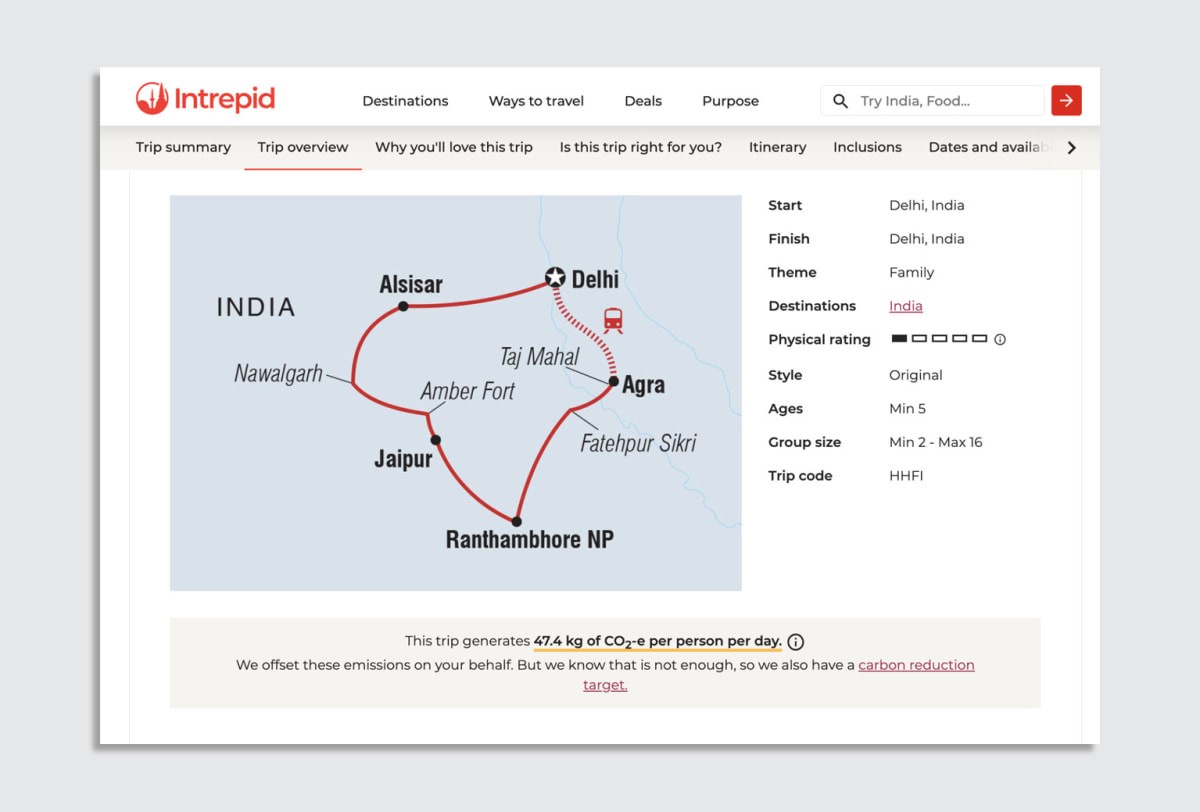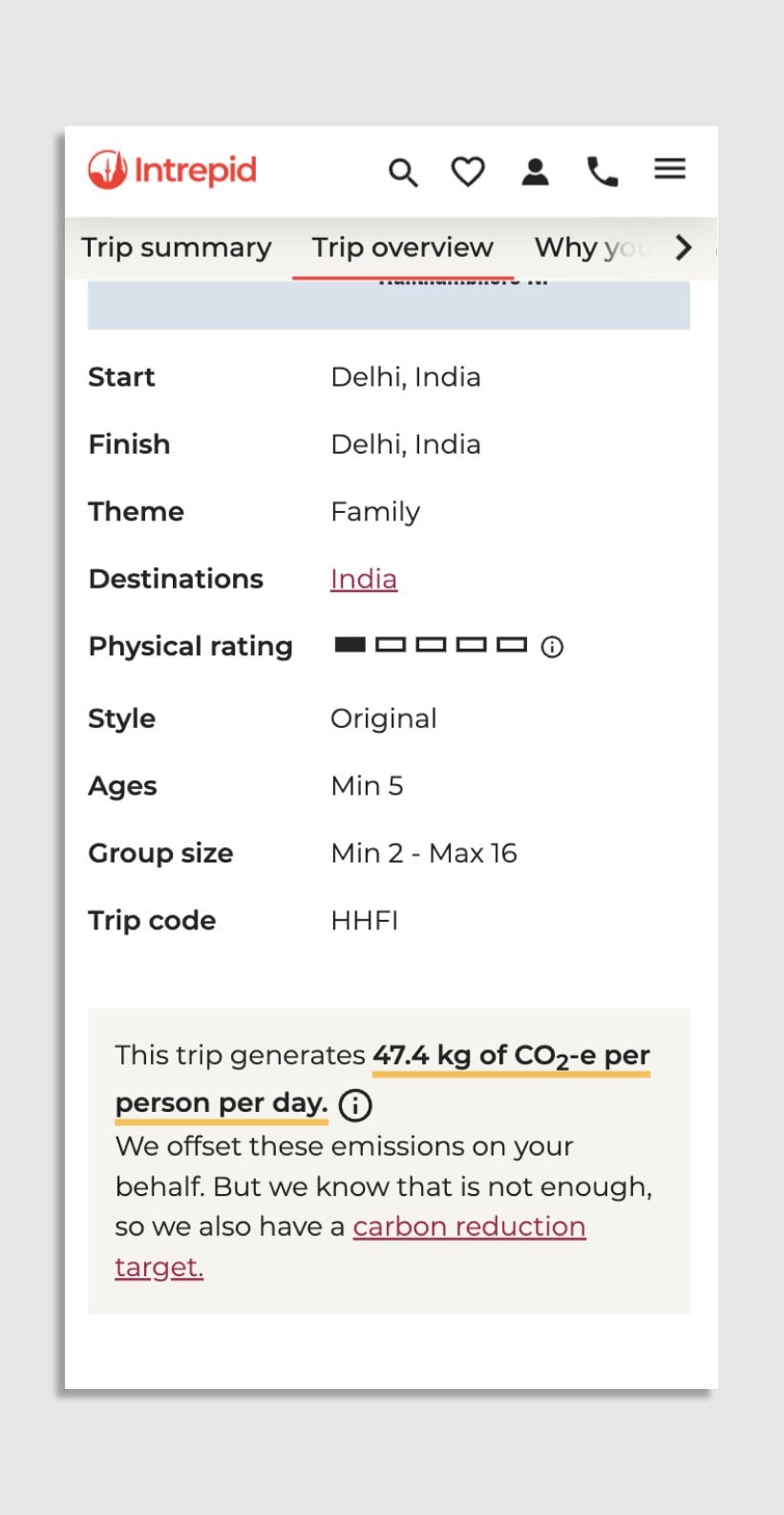This travel company’s new carbon labeling program will give you the toll of your jet-setting ways
What if you could understand your travel’s environmental impact by glancing at a simple set of numbers, much like viewing nutritional facts on the back of a food label? This is the goal of Australia-based tour operator Intrepid Travel with its new carbon labeling initiative. In an industry first, Intrepid is comprehensively highlighting the total carbon emissions produced by each trip on 500 of its top itineraries. The number =—representing the amount of CO2-e (carbon dioxide equivalent) emitted per person per day—will be front and center on each trip itinerary, empowering travelers to make environmentally informed decisions about their vacations.
Working with Ndevr Environmental, an Australia-based advisory firm which helps companies such as Lexus, Quatas, and Chobani develop sustainable business practices and reduce their carbon footprint, Intrepid broke down its trips into six emitter categories: accommodations, transport, activities, dining, waste, and its own office operations. From there, Ndevr provided CO2-e emission estimates on a country level based on factors such as miles traveled or a hotel’s star rating. Intrepid then used these results to calculate the average carbon footprint per passenger per day. (Intrepid has yet to include airline emissions in its overall calculations—travelers book their own pre- and post-trip flights—but it’s working to do so, as more than 40% of a trip’s emissions typically come from transportation.)

“It’s a guide rather than an exact science,” says Intrepid’s CEO James Thornton. “But carbon calculations are increasingly more accurate, and we plan to update these numbers as technology advances.” (Intrepid also adds a 15% contingency to each trip’s carbon total to adjust for any neglected emissions.) Intrepid plans to pair CO2 numbers with information on how it offsets these emissions, through renewable energy programs like Tasman Environmental Market, which supports wind farms in Tamil Nadu, India. (Intrepid is in the process of diversifying its carbon offset portfolio to include more sequestration and nature-based solutions). It will also demystify the numbers by making simple comparisons between the carbon generated by travel activities and equivalent everyday actions like driving or charging a cell phone.

Take, for example, Intrepid’s popular Vietnam Express Southbound trip. It includes various transports (an overnight boat trip, a sleeper-car train ride, a flight from Hoi An to Ho Chi Min City) as well as a motorbike tour of central city Hue. The 10-day adventure emits 73.59 CO2-e per traveler per day. In contrast, the eight-day Egypt Adventure, which covers three destinations by train and boat, as well as tours of the Great Pyramids in Cairo and a visit to a Nubian village, costs you 45.90 CO2-e per traveler per day. Emitting 100 CO2-e per day, Intrepid explains, is the equivalent of driving 248 miles in a gas-powered car. Of course, if you flew from New York, you’d also emit the equivalent of 2,248 CO2-e to Hoi An and 1,329 CO2-e to Cairo, round trip.
According to a recent survey that Intrepid conducted in partnership with the Harris Poll, 60% of travelers are more likely to book trips from companies or brands that are transparent about sustainability and carbon reduction efforts. Furthermore, 50% of respondents noted they’d be willing to change travel plans to reduce their carbon footprint even if it’s more expensive or less convenient. More than half (58%) said they’d alter their plans to reduce their carbon footprint if they could easily see and understand their personal environmental impact.
Carbon labeling is Intrepid’s latest push to make its operations more sustainable. The world’s largest travel-industry B Corp, Intrepid was carbon neutral by 2010. Two years ago, it also committed to setting emission reduction goals via the Science Based Targets initiative by 2025. And in an effort to bring more minority access and leadership to the travel space, it created a set of actionable ethical marketing guidelines to help diversify its trips, staff, and partners. To bring down air travel emissions, Intrepid is also working to eliminate, in 2024, more than 4,000 short-haul flights from its itineraries—from Siem Reap to Phnom Penh on its Cambodia trips, for example—as well as all scenic flights.

Other travel companies have launched data-backed impact efforts as well in recent years. In 2018, Toronto-based tour operator G Adventures created the Ripple Score, which measures the amount of money that stays within the local communities where the company operates, rather than being filtered out to large international tourism entities, as many travel dollars are. The average Ripple Score of a G Adventure is 93%, meaning 93% of the money the company spends per traveler stays in the places they visit. The Ripple Score is placed front and center on every trip’s itinerary, and is updated annually.
Impact measurement efforts by other travel outfitters is only good news to Intrepid, which hopes to inspire its travelers and other companies alike. Thornton notes he’s seeing meaningful action within the travel sector to address the industry’s environmental burden—travel currently accounts for between 8 to 11% of global carbon emissions annually—but many industry leaders still have their heads in the sand. “Our industry has a front row seat to the climate emergency,” says Thornton, “yet only a small portion of companies in the travel and tourism industry actually measure and decarbonize their operations and value chains.”
Thornton credits travelers for pushing the industry forward, but hopes that they won’t have to play that role much longer. “We strongly believe that carbon labeling will soon become standard practice and, increasingly, a part of government policy,” he says, “putting the onus of carbon emission reduction and offsetting on companies rather than consumers.” It all starts, Intrepid believes, with accessible data in the hands of consumers.
(14)



